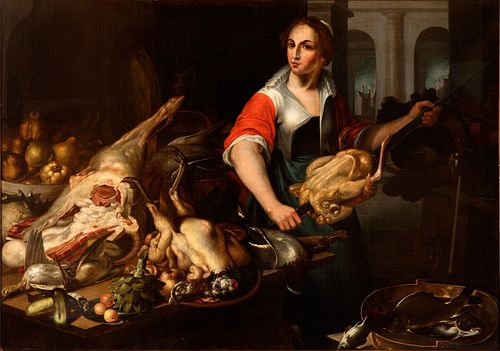BALTHASAR HUYS (Mechelen, Belgium, 1590 - Rotterdam, Netherlands, 1652). "Kitchen still life with figure", 1645. Oil on canvas. Relined.
Lot 82
About Seller
Setdart Auction House
Carrer Aragó 346
Barcelona
Spain
Setdart Subastas was born in 2004 and is currently the first online art auction in Spain with solidity, prestige and reliability guaranteed by our more than 60,000 users. Setdart has a young, dynamic and enterprising team ready to successfully manage the purchase and sale of art works through custom...Read more
Estimate:
EUR€30,000 - EUR€35,000
$31,250 - $36,458.33
Absentee vs Live bid
Two ways to bid:
- Leave a max absentee bid and the platform will bid on your behalf up to your maximum bid during the live auction.
- Bid live during the auction and your bids will be submitted real-time to the auctioneer.
Bid Increments
| Price | Bid Increment |
|---|---|
| EUR€0 | EUR€10 |
| EUR€200 | EUR€25 |
| EUR€500 | EUR€50 |
| EUR€1,000 | EUR€100 |
| EUR€3,000 | EUR€200 |
| EUR€5,000 | EUR€500 |
| EUR€10,000 | EUR€1,000 |
| EUR€20,000 | EUR€2,000 |
| EUR€50,000 | EUR€5,000 |
About Auction
By Setdart Auction House
Nov 3, 2021
Set Reminder
2021-11-03 08:00:00
2021-11-03 08:00:00
America/New_York
Bidsquare
Bidsquare : OLD MASTERS
https://www.bidsquare.com/auctions/setdart-auction-house/old-masters-7786
Setdart Auction House sofia@setdart.com
Setdart Auction House sofia@setdart.com
- Lot Description
BALTHASAR HUYS (Mechelen, Belgium, 1590 - Rotterdam, Netherlands, 1652). "Kitchen still life with figure", 1645. Oil on canvas. Relined. Signed and dated in the lower area. Presents a modern frame and frame of the nineteenth century. Measurements: 104 x 148,5 cm; 137 x 181 cm (frame). Work published in J. de Maere and M. Wabbes, "Illustrated dictionary of 17th Century Flemish painters" (Brussels: La Renaissance du Livre, 1993), p. 635. A painter active between about 1612 and 1652, the year of his death, Balthasar Huys belonged to the Flemish school of the early Baroque, and specialized in still life painting. He was a pupil of Jean-Baptiste Saive. He is currently represented in the SØR Rusche collection in Berlin, among other outstanding collections, mainly European. This work combines two of the great genres of Flemish and Dutch Baroque: genre painting and still life. Thus, the still life is presented as part of a more complex composition, starring a large figure that also takes center stage by looking directly at the viewer, integrating it into the scenario, a distinctly baroque scenographic resource. The various foods are arranged in the foreground, in an open, asymmetrical and dynamic composition, typically baroque. The cook is placed in the background, captured three-quarter length, holding a large roasting stick on which a large bird is strung. In this type of compositions it is usual to close the space behind the figure, with a dark background or in semi-darkness, as we see on the left side of the image. However, here Huys opens the space in depth on the right side, allowing us to see a perfectly worked architectural scene; a second room illuminated with natural light, of classical architecture, behind whose arches we can guess the buildings of a typical Flemish city of the time, highlighted against a sky of greenish blue tone, somewhat dark. The still life with large figures of the Flemish school has its origin in the sixteenth century, in the works of Pieter Aertsen (1508-1575) and Joachim Beuckelaer (1533-1574). Both painters made great paintings that advanced the Baroque by their naturalism and scenographic value, although they still show the motley of elements typical of Mannerism. Pieter Aerstsen created a formula that consists of placing the figure in the foreground, surrounded by large-scale foodstuffs, always painted with special attention to quality and detail, following the Flemish tradition. Beuckelaer, a disciple of Aertsen, took this model created by his master and used it to represent religious scenes, which always remain in the background compared to the still life. In fact, it is likely that Velázquez took his compositional idea for "Christ in the House of Martha and Mary" (1618, London, National Gallery) from him, probably through an engraving by Cornelis Cort. Already in the 17th century, the still life genre with figures would gain great importance in the Flemish school, with more dynamic and theatrical compositions, fully framed within the Baroque style, as we see here.
- Shipping Info
-
In-house shipping available. Please inquire at admin@setdart.com.
-
- Buyer's Premium



 EUR
EUR CAD
CAD AUD
AUD GBP
GBP MXN
MXN HKD
HKD CNY
CNY MYR
MYR SEK
SEK SGD
SGD CHF
CHF THB
THB

















